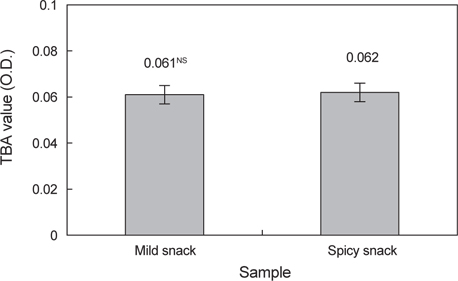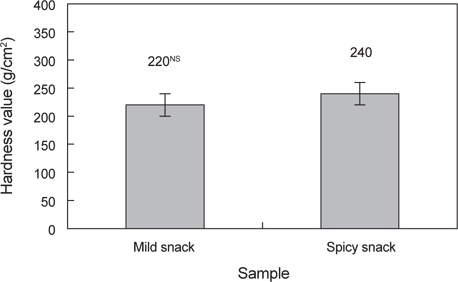



Snack은 주로 간식 개념으로 넓게는 가볍게 먹는 모든 식품을 지칭하며, 좁게는 과자류의 편이 snack을 의미할 수 있다(Shin, 1989). 산업현장에서 편이 snack 제조의 핵심공정은 성형/굽기, 유탕, 소금 및 자갈을 이용한 튀김/coating 등의 맛내기이며, 한과를 비롯하여 시판되는 대부분의 snack류는 이 방법으로 제조하고 있다. 우리나라의 2010년도 과자류 총 매출액 25,910억원 중 snack류 매출액은 8,278억원이며, 2014년 과자류 총 매출액 34,101억원 중 snack류 매출액은 9,808억원으로 snack류는 과자류 총 매출액 중 약 30%를 차지하여 매우 큰 시장을 형성하고 있다(MFDS, 2014).
본 연구에 사용되는 새우류의 한국 총 생산량은 2006년 29,389 M/T, 2011년 33,817 M/T, 2014년 34,428 M/T이었으며, 냉동품, 소건품, 자건품을 합하여 2006년 2,292 M/T, 2011년 10,471 M/T, 2014년 11,057 M/T이 소비되어 전체 생산량 중 약 27%가 가공용으로 사용되었다(KOSIS, 2015). 새우의 주요 구성아미노산은 glutamic acid, lysine, arginine 및 phenylalanine 등이며, 특히 우리나라 사람들에게 결핍되기 쉬운 lysine과 같은 곡류 제한아미노산이 많이 함유되어 있고, taurine, arginine, glycine 및 proline 등이 풍부하여 향미증진제의 역할을 한다. 무기질로는 칼슘 함량이 가장 많으며, 인, 나트륨, 마그네슘, 망간, 철 등이 함유되어 있다(Cho and Kim, 2009a). 새우분말 첨가식품에 관한 연구는 주로 새우첨가 두부(Cho and Kim, 2009a), 새우첨가 쿠키(Cho and Kim, 2009b), 새우첨가 어묵(Seo and Cho, 2012), 새우첨가 만두피(Kim et al., 2009) 등의 가공품에 관하여 보고되었으나, snack과 관련된 연구보고는 찾아보기 힘들다.
한편, 한국과 일본에서 주식으로 사용되는 쌀(
본 연구에서는 새우첨가 extrusion 쌀 collet을 소재로 하여 순한 맛 snack 및 매운맛 snack을 제조하였으며, 아울러 이화학적 및 관능적 품질특성에 대하여 조사하였다.
실험에 사용한 쌀(
실험에 사용한 쌀의 일반성분은 수분 16%, 탄수화물 75%, 조단백질 7%, 조지방 1.3%, 회분 0.6%이었으며, 마른 새우의 일반성분은 수분 21%, 조단백질 54.5%, 조지방 5.5%, 회분 16.0%이었다.
전보(Je et al., 2015a)의 결과를 활용하여 분체배합기(Model KD, Kumgang Co., Korea)로 쌀:마른새우:식염을 96.7:3.0:0.3으로 배합한 후, barrel 온도 100℃, screw 속도 280 rpm, 토출구 직경 7 mm, 원료투입량 45 kg으로 single extruder (Model No KE 1, Kumgang Co., Korea)의 작동조건을 조정한 후 함수율 1.5%의 새우첨가 쌀 collet을 제조하였다.
전보(Je et al., 2015b)의 결과를 활용하여 새우첨가 쌀 collet을 경남 고성소재 (주)수 농수산바이오의 코팅 tumbler (Model CTK, Kumgang Co., Korea)를 이용하여 순한맛 snack은 식용유 코팅과 혼합조미분말스프 코팅의 2가지 공정을 거쳐 제조하였으며, 매운맛 snack은 식용유코팅, 혼합조미분말스프 코팅 및 분말고추장 코팅의 3가지 공정을 거쳐 제조하였다. 즉, 식용유 코팅은 식용유(collet의 중량에 대하여 식용유 20%) 첨가, 코팅 tumbler 온도 60℃, 코팅 tumbler 속도 80 rpm 및 코팅시간을 4분으로 설정하여 작업하였고, 혼합조미분말스프 코팅은 혼합조미분말스프(식용유 코팅된 collet의 중량에 대하여 혼합조미분말스프 3%) 첨가, 코팅 tumbler 온도 50℃, 코팅 tumbler 속도 70 rpm 및 코팅시간을 3분으로 설정하여 작업하였으며, 분말고추장 코팅은 분말고추장(혼합조미분말스프 코팅된 collet의 중량에 대하여 분말고추장 2%) 첨가, 식용유(혼합조미분말스프 코팅된 collet의 중량에 대하여 9%) 첨가, 코팅 tumbler 온도 50℃, 코팅 tumbler 속도 70 rpm 및 코팅시간을 1분으로 설정하여 작업하였다.
일반성분은 AOAC (1995)법에 따라 수분은 상압가열건조법, 조지방은 Soxhlet법, 회분은 건식회화법, 조단백질은 semimicro Kjeldahl법으로 정량하였으며, pH는 시료에 10배량의 순수를 가하여 균질화한 후 pH meter (pH 1500, Eutech Instruments, Singapore)로써 측정하였고, 염도는 Mohr (AOAC, 1995)법으로 측정하였다.
각 시료의 L값(lightness, 명도), a값(redness, 적색도), b값(yellowness, 황색도) 및 ⊿E값(color difference, 색차)을 직시색차계(ZE-2000, Nippon Denshoku, Japan)로써 측정하였고, 이 때 표준백관(standard plate)의 L값은 99.98, a값은 −0.01, b값은 0.01이었다.
총아미노산의 분석을 위한 시료는 0.2 g을 정밀히 취하여 시험관에 넣고 6 N HCl을 2 mL 가하고, 밀봉하여 110℃의 heating block (HF21, Yamato, Japan)에서 48시간 동안 가수분해 시켰다. Glass filter로 여과하고 얻은 여액을 진공회전증발기(RW-0528G, Lab. Companion, Korea/C-WBE-D, Changshin Sci., Korea/Rotary evaporator N-1000, EYELA, Japan)로 60℃에서 감압 농축하여, sodium citrate buffer (pH 2.2)로 25 mL 정용 플라스크에 정용하여 제조하였다. 총아미노산의 분석은 전처리한 각 시료의 일정량을 아미노산자동분석기(Automatic amino acid analyzer S-433, Sykam, Germany)에 주입하여 실시하였으며, 이를 토대로 동정 및 정량 하였다.
유리아미노산 함량은 시료 20 g에 20% trichloroacetic acid (TCA) 30 mL를 가하고 vortex mixer (G-560, Scientific Industries, USA)로 30분간 균질화한 후 원심분리기(SUPRA 22K Plus, Hanil Science Industrial Co., Ltd, Korea)로 8,000 rpm에서 15분간 원심분리 시킨 다음 100 mL로 정용하였고, 분액여두에 옮겨 에틸에테르를 가한 후 격렬히 흔들어 상층부의 에테르층을 버리고 하층부만을 취하여 진공회전증발기로 농축하였다. Lithium citrate buffer (pH 2.2)를 사용하여 25 mL로 정용한 후 아미노산자동분석계로 측정하였다.
시료 5 g을 회분도가니에 일정량을 취해 전기회화로(Electric muffle furnace, Dongwon Scientific Co., Korea)를 사용하여 500-550℃에서 5-6시간 건식 회화시킨 후 ashless filter paper로 여과하여 일정량으로 정용한 다음, ICP (Atomscan 25, Tja, Co., USA)로 K, Ca, Mg, Na, P, S, Zn 및 Fe의 함량을 조사하였다.
지질 산패도를 나타내는 thiobarbituric acid (TBA)값은 수증기증류법(Tarladgis et al., 1960)으로 측정하였다.
조직감은 레오메터(Rheometer Compac-100, Sun Scientific Co., Japan)를 사용하여 절단시험으로 질김도를 측정하였다. 즉, snack제품을 레오메터로 절단하는데 소요되는 힘으로 나타내었다. 이때 max force 값의 계산은 rheology data system ver. 2.01에 의해 처리하였다.
관능검사는 10인의 관능검사원을 구성하여 형상, 색도, 향미, 식미, 식감 등 관능적 기호도의 척도가 되는 항목에 대하여 5단계 평점법(5: 아주 좋음, 4: 좋음, 3: 보통, 2: 싫음, 1: 아주 싫음)으로 평가하였고, 평가점수 중 최고 및 최저값을 뺀 나머지 점수의 평균값으로 결과를 나타내었다. 데이터 통계처리는 ANOVA test를 이용하여 분산분석한 후, Duncan의 다중위 검정(Steel and Torrie, 1980)으로 최소유의차 검정(
순한맛 및 매운맛 snack의 일반성분, 염도 및 pH값은 Table 1에 나타내었다. 일반성분의 경우 순한맛 및 매운맛 snack의 수분함량은 각각 2.44% 및 2.24%, 조지방함량은 각각 18.36% 및 26.54%. 조단백질함량은 각각 8.52% 및 8.64%, 회분함량은 각각 1.28% 및 1.38%로 수분, 조단백질, 회분 함량은 큰 차이가 없었으나, 조지방은 순한맛 snack에 비해 매운맛 snack이 그 함량이 높았다. 순한맛 snack에 비해 매운맛 snack의 조지방 함량이 높은 이유는 매운맛 snack의 경우 분말고추장 코팅 시 별도로 사용된 식용유 때문으로 생각되었다. 순한맛 및 매운맛 snack의 염도는 각각 1.1% 및 1.2%, pH는 각각 6.95 및 6.86로 차이가 거의 없었다. 수분함량은 collet의 함수율이 1.5%이었으나, 순한맛 및 매운맛 snack이 각각 2.44% 및 2.24%로 증가하였는데, 이것은 코팅과정에서의 흡습에 의한 영향 때문이라고 판단되었다. 산업현장에서는 일반적으로 함수율이 4% 이하이면 상품성이 있다고 판단하는데 본 실험에서의 순한맛 snack과 매운맛 snack의 경우 수분함량은 각각 2.44% 및 2.24%였으므로 상품성이 있다고 판단되었다.

Comparison in proximate composition, salinity and pH of the mild and spicy snack produced by using extrusion rice collet added with dried shrimp Acetes chinensis
Maryam et al. (2015)은 압출 팽화 옥수수 새우 snack의 수분, 조단백질, 조지방 및 회분함량은 각각 2.5-2.6%, 6.3%, 28.1-28.2% 및 4.19%로 보고하였는데, 본 실험에서의 수분, 조단백질 및 회분함량은 큰 차이가 없었으나 조지방함량은 차이가 있었다.
순한맛 및 매운맛 snack의 색도는 Table 2와 같다. L값(명도)은 각각 61.22 및 57.40, a값(적색도)은 각각 6.16 및 9.30, b값(황색도)은 각각 19.23 및 21.66, ⊿E값(색차)은 각각 40.71 및 45.72로 명도는 매운맛 snack에 비해 순한맛 snack의 값이 높았으나, 적색도 및 황색도는 매운맛 snack의 값이 높았다. 이와 같이 순한맛 snack과 매운맛 snack의 색도가 차이가 나는 것은 매운맛 snack의 경우 분말고추장이 첨가되었기 때문으로 판단되었다.
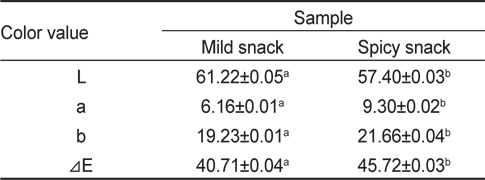
Comparison in color value of the mild and spicy snack produced by using extrusion rice collet added with dried shrimp Acetes chinensis
Park et al. (1980)은 소금튀김 및 기름튀김한 멸치 snack의 L값(명도)은 각각 39.6 및 45.1, a값(적색도)은 각각 10.1 및 9.1, b값(황색도)은 각각 16.2 및 19.9, ⊿E값(색차)은 각각 59.0 및 57.6로 소금튀김한 제품이 기름튀김한 제품보다 L값 및 b값은 낮았으나, a값 및 ⊿E값은 높았다고 보고하였다. 본 실험의 결과와 비교하여 a값 및 b값은 큰 차이가 없었으나, L값 및 ⊿E값은 차이가 있었는데, 이것은 본 실험에서는 비 가열공정인 유처리 코팅으로 새우 snack을 제조하였기 때문이라고 판단되었다.
순한맛 및 매운맛 snack의 총아미노산 함량은 Table 3에 나타내었으며, 그 값은 각각 7,776.4 및 7,655.8 mg/100 g이었다. 순한맛 및 매운맛 snack 모두 glutamic acid가 각각 1,795.2 (22.5%) 및 1,604.8 mg/100 g (20.5%)으로 가장 많은 함량을 차지하였으며. 그 다음으로 aspartic acid, leucine, arginine, phenylalanine, valine 순이었고, 순한맛 및 매운맛 snack의 총아미노산 함량 차이는 거의 없었다.
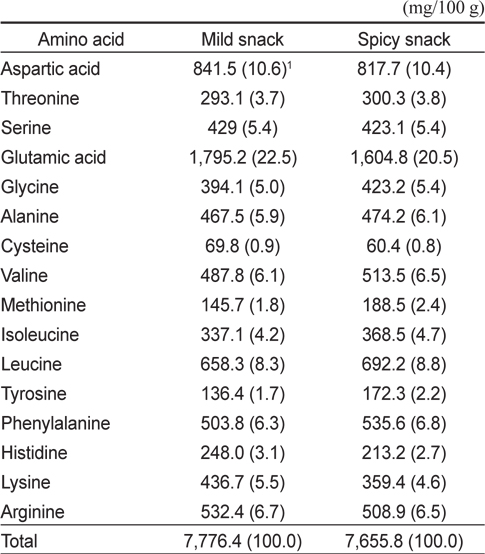
Comparison in total amino acid content of the mild and spicy snack produced by using extrusion rice collet added with dried shrimp Acetes chinensis
쌀의 제1 제한아미노산인 lysine은 213 mg/100 g, 제2 제한아미노산인 threonine은 173 mg/100 g이었으며(Kim et al., 1984), 꽃새우의 lysine은 1,397 mg/100 g, threonine은 649 mg/100 g (NIFS, 2014)이라고 보고되었는데, 본 실험에서의 순한맛 및 매운맛 snack의 lysine은 각각 436.7 및 359.4 mg/100 g, threonine은 각각 293.1 및 300.3 mg/100으로 조사되어 새우 첨가로 순한맛 및 매운맛 snack에는 쌀에 부족한 곡류 제한아미노산이 쌀에 비하여 2배가량 증가되었다.
Kang et al. (2007)은 넙치프레임 첨가 snack을 제조한 후 총아미노산 함량을 조사한 결과, glutamic acid가 1633.6 mg/100 g (17.6%)으로 가장 많은 함량을 차지하였으며. 그 다음으로 leucine (9.3%), aspartic acid (8.9%), proline (8.0%) 순이었다고 보고하여, 본 연구의 결과와 유사하였다.
순한맛 및 매운맛 snack의 유리아미노산 함량은 Table 4에 나타내었으며, 그 값은 각각 221.6 및 253.5 mg/100 g이었다. 두 시료 모두 asparagine이 각각 32.6 및 38.4 mg/100 g (14.7% 및 15.1%)으로 유리아미노산 중 가장 함량이 많았으며, 그 다음으로 glutamic acid, glycine, arginine, alanine, leucine 순으로 나타났다.
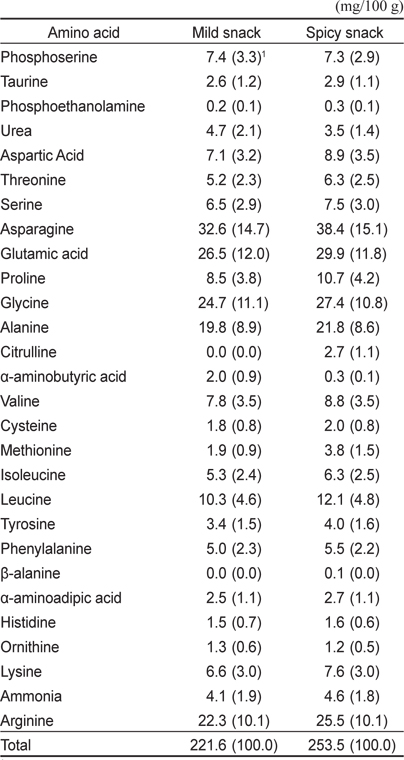
Comparison in free amino acid content of the mild and spicy snack produced by using extrusion rice collet added with dried shrimp Acetes chinensis
Glutamic acid는 맛에 가장 큰 영향을 미치며, 다른 정미성분과 공존할 시에는 맛의 상승 작용을 나타내기도 한다고 하였고(Kim et al., 2011), glutamate는 mono sodium 염의 형태로 조미료의 원료로 사용되는 umami의 원료가 되며, 수용성 아미노산인 aspartate 등은 umami를 내는 맛의 중요한 요소라고 하였다(Oh et al., 2011). Careri et al. (1993)은 이탈리아형 drycured 햄의 관능적 특성에 관한 연구에서 lysine과 tyrosine은 숙성된 맛, phenylalanine과 isoleucine은 신맛에 기여를 한다고 하였으며, Kim et al. (2013)은 한우의 경우 유리아미노산 중 단맛은 alanine, 신맛은 arginine, isoleucine 및 leucine이 연관이 있다고 하였고, Mau and Tseng (1998)은 발효햄의 숙성과정 중 ornithine, isoleucine, tryptophan, methionine, tyrosine, threonine, glycine의 증가가 쓴맛의 주요물질이라고 하였다. Kim et al. (2014)은 산성 아미노산인 L-asparagine의 첨가는 L-arginine의 짠맛을 감소시키는 약점이 있으나, L-arginine의 단점인 강한 쓴맛과 떫은맛을 억제하는 특성을 나타낸다고 하였다.
본 실험에서 제조한 snack 제품의 맛에 영향을 미치는 유리아미노산이 다양하게 함유되어 있는 것은 새우에서 비롯된 것으로 판단되었다.
순한맛 및 매운맛 snack의 무기질 함량은 Table 5에 나타내었으며, Na 함량은 각각 462.1 및 514.9 mg/100 g으로 가장 많았고, K 함량은 각각 234.2 및 221.4 mg/100 g, P 함량은 각각 221.9 및 226.3 mg/100 g, Ca 함량은 각각 191 및 199.4 mg/100 g으로 두 시료의 무기질 함량은 큰 차이가 없었다.
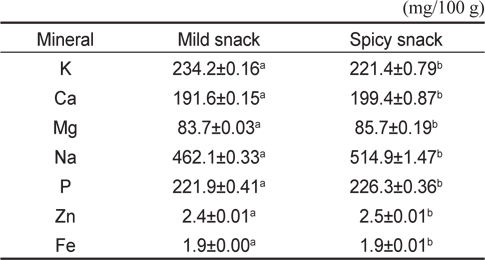
Comparison in mineral content of the mild and spicy snack produced by using extrusion rice collet added with dried shrimp Acetes chinensis
K는 Na의 과잉섭취로 유발되는 고혈압에 대해 보호기능이 있는 것으로 알려져 있으며, Na/K 섭취비를 1에 가깝게 유지하면 고혈압의 예방과 개선에 효과가 있다고 알려져 있다(Kim et al., 2009; Lim et al., 2012). Cho et al. (2000)은 Ca의 함량보다는 흡수율이 중요하고 흡수율에는 여러 가지 인자가 영향을 미치는데 그 중 하나가 P의 존재 비율(1:2-2:1)이라고 하였는데, 본 연구에서의 순한맛 및 매운맛 snack의 Na/K 비는 각각 1.97 및 2.33이었고, Ca:P 비율은 각각 1:1.16 및 1:1.13으로 두 시료 모두 상기 범위 내에 있었다. Kim et al. (2006)은 붕장어 frame을 이용하여 제조한 snack의 무기질함량은 Ca 4,229.9 mg/100 g, P 2,702.5 mg/100 g, Fe 2.7 mg/100 g, Zn 11,2 mg/100 g이라고 보고하여 본 연구에서의 순한맛 및 매운맛 snack의 무기질 함량과 차이가 있었다.
순한맛 및 매운맛 snack의 TBA값은 Fig. 1에 나타내었으며, 그 값은 각각 0.061 및 0.062로 거의 비슷한 값이었다. Lee et al. (1989)은 소금튀김 및 기름튀김한 멸치 snack의 TBA값은 0.1-0.15 범위라고 보고하여 본 실험의 결과와 차이가 있었다. 이것은 본 실험에서는 함수율이 낮은 collet에 가열하지 않은 식용유를 사용하여 코팅하였기 때문에 TBA값이 낮은 것으로 사료되었다.
순한맛 및 매운맛 snack의 조직감의 차이를 비교하기 위해 각 시료의 조직감을 레오메터로 측정한 결과는 Fig. 2와 같다. 순한맛 및 매운맛 snack의 조직감값은 각각 220 및 250 g/cm2으로 매운맛 snack의 조직감값이 약간 높았으나, 식감의 차이를 느낄 수 있는 정도는 아니었다.
Jo et al. (1999)은 대두유로 튀김하여 제조한 멸치팽화 snack의 조직감을 측정한 결과, 180℃로 튀김한 제품의 crispness (파삭파삭한 정도)값은 2.97 m−1, brittleness (부서지는 정도)값은 0.58 kg−1이라고 하였으나, 본 실험에서의 조직감 측정 방법과의 차이로 인하여 데이터를 비교할 수가 없었다.
Snack의 취식 시 식감은 함수율과 밀접한 연관이 있으며, 바삭하게 씹히는 느낌은 snack에서 중요한 관능적 요소라고 판단하는데, 산업현장에서는 collet형 snack의 경우 대략 100 g/cm2 이상이면 상품성이 있다고 판단하고 있으므로 본 실험에서 제조한 순한맛 및 매운맛 snack은 상품성이 있다고 사료되었다.
순한맛 및 매운맛 snack에 대하여 잘 훈련된 10인의 관능검사원을 구성하여 5단계 평점법으로 관능검사를 실시한 결과는 Table 6과 같다. Snack의 형상, 색도, 향미, 식미, 식감, 종합평가의 평점 결과 매운맛 snack이 순한맛 snack에 비하여 형상과 조직감은 유사하였으나, 그 외의 항목은 미미하게 우위에 있었는데, 이러한 것은 매운맛 snack 제조 공정에서의 분말고추장 코팅이 영향을 미친 것으로 판단되었다. 그러나 두 시료의 종합 비교에서는 관능검사원들의 기호에 따라 순한맛 snack과 매운맛 snack의 선택이 뚜렷하였고, 재 구매에 직접적인 영향을 미치는 향미(냄새), 식미(맛), 식감(바삭함) 및 전체선호도가 2종 모두 좋음 이상으로 평가된 것은 snack의 함수율이 낮아 식감이 바삭바삭하고 새우 특유의 냄새가 영향을 미친 것으로 판단되었다. 따라서 순한맛 snack 및 매운맛 snack 모두 맛의 독특한 차이가 있어 두 시료 모두 상품성이 있다고 판단되었다.

Sensory evaluation of the mild and spicy snack produced by using extrusion rice collet added with dried shrimp Acetes chinensis







